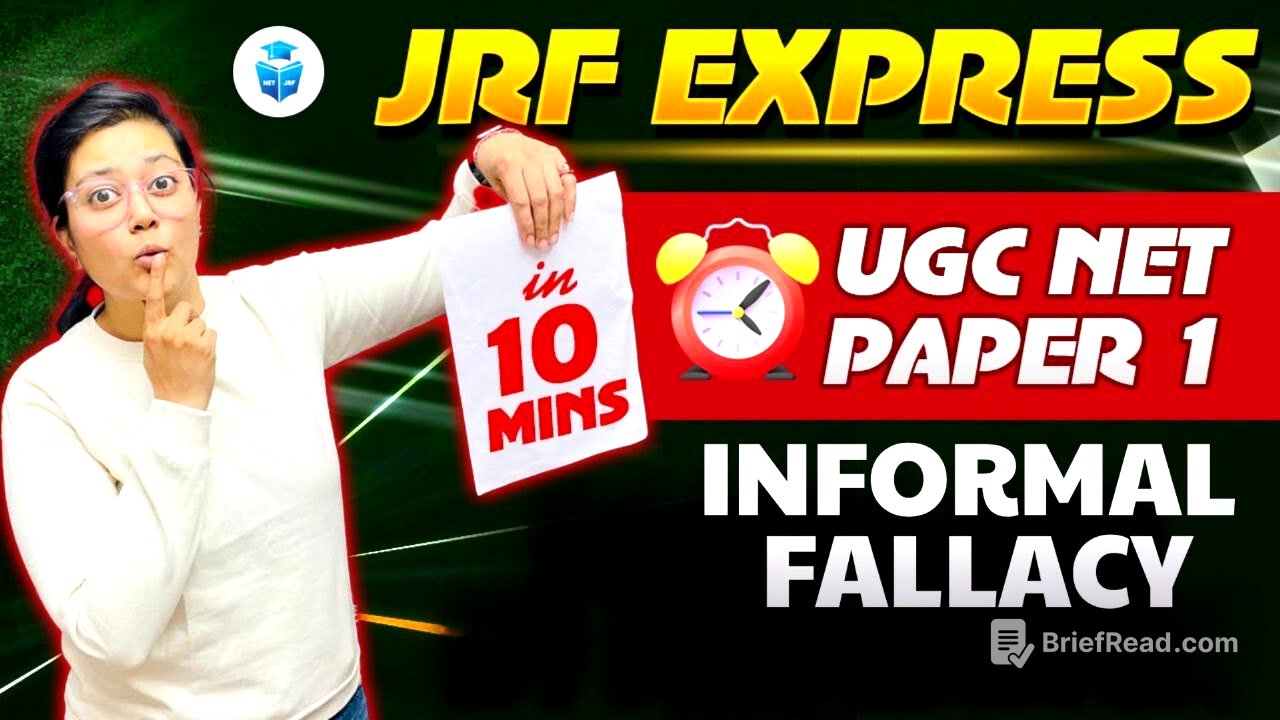TLDR;
This video provides a concise 10-minute revision of informal fallacies, distinguishing them from formal fallacies. It categorizes informal fallacies into relevance, weak induction, presumption, and ambiguity, offering examples and explanations of common types within each category. The session aims to equip viewers with the knowledge to identify and understand these fallacies, which are frequently tested in logical reasoning questions.
- Informal fallacies are errors in reasoning that stem from the content of an argument rather than its structure.
- The video categorizes and explains various types of informal fallacies, including those of relevance, weak induction, presumption, and ambiguity.
- Real-life examples and scenarios are used to illustrate each type of fallacy, making it easier for viewers to grasp the concepts.
Introduction to Informal Fallacies [1:50]
The session starts with an explanation of informal fallacies, which are errors in reasoning that occur due to problems with the content or context of the argument, rather than its formal structure. Formal fallacies involve mistakes in the structure of an argument, while informal fallacies involve logical errors. The presenter uses the analogy of clothing to illustrate the difference between formal (structured) and informal (unstructured) settings.
Four Broad Categories of Informal Fallacies [4:08]
Informal fallacies are categorized into four main groups: fallacies of relevance, weak induction, presumption, and ambiguity. Fallacies of relevance occur when the premises of an argument are not logically relevant to the conclusion. Weak induction fallacies happen when the evidence provided is not strong enough to support the conclusion. Fallacies of presumption involve making unwarranted assumptions. Fallacies of ambiguity arise from unclear or misleading language.
Fallacies of Relevance [6:02]
Fallacies of relevance include ad hominem (attacking the person instead of the argument), ad baculum (appeal to force), ad populum (appeal to popularity), straw man (misrepresenting an opponent's argument), and red herring (diverting attention from the main issue). Ad hominem involves attacking the person making the argument rather than the argument itself. Ad baculum uses threats or force to compel acceptance of a conclusion. Ad populum argues that something is true because it is popular. The straw man fallacy misrepresents an opponent's argument to make it easier to attack. Red herring diverts attention from the main issue to an irrelevant topic.
Weak Induction Fallacies [10:40]
Weak induction fallacies include weak analogy, unqualified authority, appeal to ignorance, hasty generalization, false cause, and slippery slope. Weak analogy involves drawing a conclusion based on a comparison that is not strong enough. Unqualified authority relies on the testimony of someone who is not an expert on the topic. Appeal to ignorance argues that something is true because it has not been proven false, or vice versa. Hasty generalization draws a conclusion based on insufficient evidence. False cause assumes a causal relationship where none exists. Slippery slope argues that one event will inevitably lead to a series of negative consequences.
Fallacies of Presumption [14:05]
Fallacies of presumption include begging the question, complex question, and false dichotomy. Begging the question (also known as petitio principii or circular argument) assumes the conclusion in the premise. A complex question is a question that contains an unwarranted assumption. False dichotomy presents only two options when more possibilities exist.
Fallacies of Ambiguity [15:55]
Fallacies of ambiguity include composition, division, accent, amphiboly, and equivocation. Composition assumes that what is true of the parts is true of the whole. Division assumes that what is true of the whole is true of the parts. Accent changes the meaning of a statement by emphasizing different words. Amphiboly involves ambiguity due to grammatical structure. Equivocation uses a word in two different senses within the same argument.
Example and Conclusion [18:59]
The presenter provides an example question to illustrate how these fallacies are tested. In the example, a famous actor's statement about astrology being a real science is presented, and the correct answer is identified as an appeal to unqualified authority. The session concludes with encouragement to review the different types of fallacies and their meanings, and to practice identifying them in arguments.







![[여의도튜브] '희토류' 큰소리 치더니 "中, 재앙이 왔다" /머니투데이방송](https://wm-img.halpindev.com/p-briefread_c-10_b-10/urlb/aHR0cDovL2ltZy55b3V0dWJlLmNvbS92aS82dlMxeG9rN3Zzby9ocWRlZmF1bHQuanBn.jpg)

